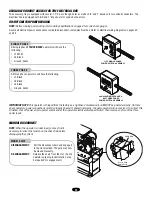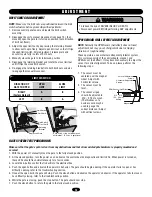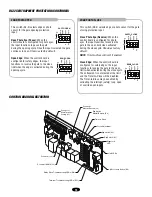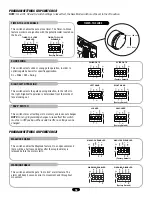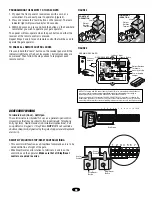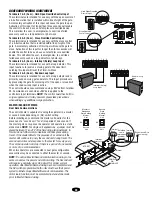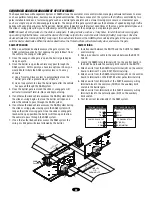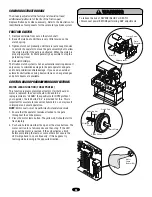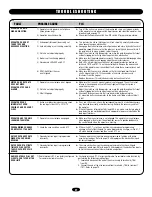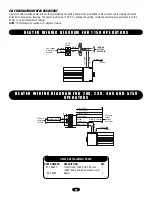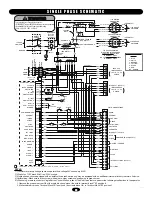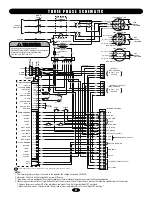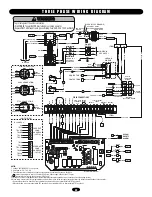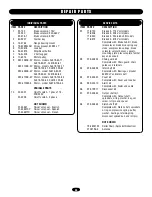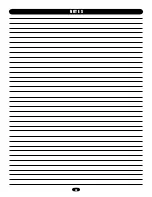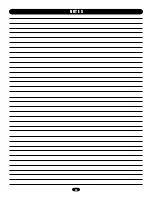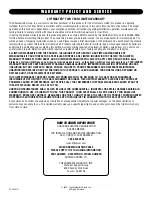
26
OPERATOR FAILS TO RUN
CONTACTOR CHATTERS
WHEN OPERATOR BEGINS
TO MOVE
OPERATOR RUNS SLOW
AND/OR TRIPS THE
INTERNAL OVERLOAD
MASTER OR SECOND
OPERATOR IS NOT
FUNCTIONING PROPERLY
1) Improper wired stop control
2) Fault in the operator
check the yellow
diagnostic LED at the top right of the
control board next to the programming dip
switches.
3) An accessory is active or malfunctioning
check the red input status LEDs, D11-D31
4) Improper J4 connector wiring
(master/second)
5) Low or no high voltage power
6) Low or no low voltage power
7) No LEDs illuminated on the
control board
T R O U B L E S H O O T I N G
➤
Check the green LED (D17) on control board. If the green LED is off, check to
make sure a stop control has been installed across terminals TB1-3 and TB1-5
of the terminal strip.
➤
If the yellow LED blinks six times, there is a master/second unit
communication failure. If operator is a single unit, make sure there is a jumper
across terminals TB1-11 and TB1-12. If operator is in a dual gate
configuration, make sure that the communication wiring between the two units
is undamaged and complete.
➤
If the yellow light is solid, the board needs to learn the motor. Follow the
directions on page 22.
➤
If any red LEDs are on, check the corresponding input. An installed accessory
may be wired incorrectly or malfunctioning. Remove the accessory and test
the operator.
➤
If the open or interrupt (safety) loop LED is on, make sure factory plug-in loop
detectors are working properly and appropriate loops are installed on the loop
input terminals.
➤
Stand-Alone Operators: Make sure there is a jumper installed across the J4
connector.
➤
Master/Second Operation: Make sure that the master/second wiring is installed
correctly and is intact (not damaged).
➤
Verify power supply to operator. It should be within 5% of the operator’s
rating when running. Make sure that the proper wire gauge was used for the
distance between breaker and operator by consulting the wiring specifications
section on page 8 of this manual.
➤
Measure the voltage at terminals R1 and R2 in the operator. This voltage
should be within 5% of 24Vac. If the high voltage power is good and the low
voltage power is bad, check to make sure the circuit fuse is not tripped and
that the correct primary tap is used on the transformer. If fuse and tap are
correct, replace the transformer.
➤
If both primary and secondary power is good, check to make sure that the J2
connector is making good contact with the pins on the control board. If all is
good, replace the control board.
1) Transformer’s secondary is overloaded
2) Low primary (high voltage) power
➤
Remove all accessory devices and test the operator. If the contactor stops
chattering, find an alternate power source for some of the devices.
➤
Verify power supply to operator. It should be within 5% of the operator’s
rating when running. Make sure that the proper wire gauge was used for the
distance between breaker and operator by consulting the wiring specifications
section on page 8 of this manual.
1) Low primary (high voltage) power
2) Problem in the motor
3) Problem in the contactor
4) Problem in the brake system
➤
Verify power supply to operator as well as the meter base or sub panel. Make
sure there is not a major change in voltage. The voltage at the operator should
be within 5% of the operator’s rating when running.
➤
Check the number of amps currently being drawn from the panel. Make sure
that the total power being drawn does not exceed the panel’s rating.
➤
Make sure that the proper wire gauge was used for the distance between
breaker and operator by consulting the wiring specifications section on page 8
of this manual.
➤
Perform a visual inspection of the motor. Examine the motor’s labels for any
distortion or signs of overheating. Replace the motor if it is humming, grinding
or making excessive noise.
NOTE:
Repeated motor problems indicate poor
primary power.
➤
Examine the contactor for sparking, smoke or burn marks. Remove the wires
from one side of the contactor, then measure the contact points for high
resistance (above 1 ohm). Replace the contactor.
➤
Make sure that the brake is disengaging when the contactor pulls in and
engaging when the contactor releases. Replace solenoid.
FAULT POSSIBLE
CAUSE
FIX
1) Failure to cycle power after setup
2) Communication wiring may be damaged or
improperly wired for dual gate operation
3) Master or second unit is not programmed
correctly
4) Master/second connection not properly
grounded
➤
The power to each unit must be cycled in order to initiate proper master/
second communication if the operators were previously in stand-alone mode.
➤
Make sure that the communication wire that is used is twisted pair and not
run in the same conduit with any power wiring. Failure to do so will result in
interference across the master/second communication line.
➤
Review program settings page 19 and check both the master and second for
proper programming.
➤
Review wiring detail for master/second systems on page 20.

